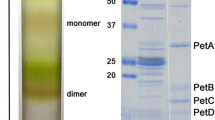Abstract
The non-thiosulfate-utilizing green sulfur bacterium Chlorobium vibrioforme contains only one soluble c-type cytochrome (c-555) besides two rubredoxins and ferredoxin. These electron transfer proteins were highly purified by ion exchange chromatography and gel filtration.
Cytochrome c-555 is a small and weakly basic hemoprotein with an isoelectric point at pH 7.3, a redoxpotential of + 80 mV, and a molecular weight of 11,500 (±500) determined by electrophoresis on sodium dodecylsulfate polyacrylamide gel, and of 11,000 by gel filtration on Sephadex G-75. Cytochrome c-555 shows maxima at 412.5 nm in the oxidized form, and three maxima in the reduced state (α-band at 555 nm with a shoulder at 551 nm, β-band at 523 nm, and γ-band at 418 nm). The best purity index (A280/A418) obtained was 0.15.
The two rubredoxins (rub I and rub II) are acidic small proteins and both have the same molecular weight of 8,100 estimated by gel filtration on Sephadex G-75 and show the same maxima at 370 nm, 492 nm, and 575 nm in the oxidized form but differ only in their isoelectric points at pH 2.9 (rub I) and at pH 2.7 (rub II). The best purity index obtained (A280/A370) was 3.27 for rub I and 3.57 for rub II respectively. Both rubredoxins contain one iron atom per molecule.
Ferredoxin is also an acidic protein with an isoelectric point at pH 2.5 and shows maxima at 300 nm and 380 nm in the oxidized form.
Similar content being viewed by others
Abbreviations
- SDS:
-
sodium dodecylsulfate
- rub:
-
rubredoxin
- TEMED:
-
N,N,N′,N′-tetramethylethylenediamine
- APS:
-
adenylylsulfate
References
Buchanan BB, Matsubara H, Evans MCW (1969) Ferredoxin from the photosynthetic bacterium, Chlorobium thiosulfatophilum. A link to ferredoxins from nonphotosynthetic bacteria. Biochim Biophys Acta 189:46–53
Dutton JE, Rogers LJ (1978) Isoelectric focussing of ferredoxins, flavodoxins and a rubredoxin. Biochim Biophys Acta 537:501–506
Evans MCW, Buchanan BB, Arnon DI (1966) A new ferredoxindependent carbon reduction cycle in a photosynthetic bacterium. Proc Natl Acad Sci USA 55:928–934
Fischer U, Trüper HG (1979) Some properties of cytochrome ć and other hemoproteins of Thiocapsa roseopersicina. Curr Microbiol 3:41–44
Fuchs G, Stupperich E, Eden G (1980) Autotrophic CO2 fixation in Chlorobium limicola. Evidence for the operation of a reductive tricarboxylic acid cycle in growing cells. Arch Microbiol 128:64–71
Fukumori Y, Yamanaka T (1979) Flavocytochrome c of Chromatium vinosum Some enzymatic properties and subunit structure. J Biochem 85:1405–1414
Gray GO, Knaff DB (1982) The role of a cytochrome c-552-cytochrome c complex in the oxidation of sulfide in Chromatium vinosum. Biochim Biophys Acta 680:290–296
Kusai A, Yamanaka T (1973a) A novel function of cytochrome c (555, Chlorobium thiosulfatophilum) in oxidation of thiosulfate. Biochem Biophys Res Comm 51P107–112
Kusai A, Yamanaka T (1973b) The oxidation mechanism of thiosulfate and sulphide in Chlorobium thiosulfatophilum. Roles of cytochrome c-551 and cytochrome c-553. Biochim Biophys Acta 325:304–314
Kusai A, Yamanaka T (1973c) Cytochrome c (553, Chlorobium thiosulfatophilum) is a sulphide-cytochrome c reductase. FEBS Lett 34:235–237
Mathewson JH, Burger LJ, Millstone HG (1968) Cytochrome c-551: thiosulfate oxidoreductase from Chlorobium thiosulfatophilum. Fed Proc 27:774
Meyer TE, Bartsch RG, Cusanovich MA, Mathewson JH (1968) The cytochromes of Chlorobium thiosulfatophilum. Biochim Biophys Acta 153:854–861
Meyer TE, Sharp JJ, Bartsch RG (1971) Isolation and properties of rubredoxin from the photosynthetic green sulfur bacteria. Biochim Biophys Acta 234:266–269
Steinmetz MA, Fischer U (1981) Cytochromes of the non-thiosulfate-utilizing green sulfur bacterium Chlorobium limicola. Arch Microbiol 130:31–37
Steinmetz MA, Fischer U (1982a) Cytochromes of the green sulfur bacterium Chlorobium vibrioforme f. thiosulfatophilum. Purification, characterization and sulfur metabolism. Arch Microbiol 131:19–26
Steinmetz MA, Fischer U (1982b) Cytochromes, rubredoxin, and sulfur metabolism of the non-thiosulfate-utilizing green sulfur bacterium Pelodictyon luteolum. Arch Microbiol 132:204–210
Trüper HG, Fischer U (1982) Anaerobic oxidation of sulphur compounds as electron donors for bacterial photosynthesis. Phil Trans R Soc Lond B 298:529–542
Yamanaka T, Kusai A (1976) The function and some molecular features of cytochrome c-553 derived from Chlorobium thiosulfatophilum. In: Singer TP (ed) Flavins and flavoproteins. Elsevier Scientific Publishing Company, Amsterdam, pp 292–301
Author information
Authors and Affiliations
Rights and permissions
About this article
Cite this article
Steinmetz, M.A., Trüper, H.G. & Fischer, U. Cytochrome c-555 and iron-sulfur-proteins of the non-thiosulfate-utilizing green sulfur bacterium Chlorobium vibrioforme . Arch Microbiol 135, 186–190 (1983). https://doi.org/10.1007/BF00414477
Received:
Issue Date:
DOI: https://doi.org/10.1007/BF00414477




